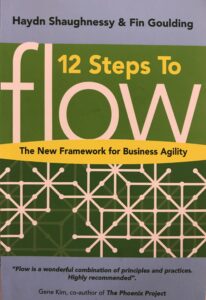Podcast: Play in new window | Download
Subscribe: RSS
This podcast covers Chapter 10, “The Customer Feedback Wall” of “12 Steps to Flow: The New Framework for Business Agility,” by Haydn Shaughnessy and Fin Goulding, developers of the internationally acclaimed workshop, Flow Academy.
The Flow Customer Feedback Wall is an additional powerful tool for bringing different parts of the business together in search of customer success. It is a venue for everybody to observe customer opinions and to participate in discussions about what has value for them. That helps focus on the personalized approach of “market-of-one.”
THREE ADDITIONAL ELEMENTS OF CUSTOMER-CENTRICITY
authenticity is critical inappropriately representing the customer voice. This can be achieved through the use of:
– Customer labs;
– The Hack Box (for internal entrepreneurs);
– Awareness of SaaS (Software as a Service) developments, especially their metrics.
Customer labs literary comprise an area where customers can work and experiment with the design team to generate new products, features, and product ideas.
The Hack Box is all about inviting individuals and teams to experiment on how best to bring a new product idea forward and test in iterate demonstrably value-adding features for customers.
The SaaS metrics are founded on the basic proposition that any customer-centric platform will improve the potential of the customer to succeed in some way. It turns pain points into strengths. One area in which there is a heavy focus is “churn.Turnover metrics are monitored to look for red flags. An example is measuring the growth of inbound inquiries.
THE CUSTOMER FEEDBACK WALL
the big advantage of the customer feedback wall is it brings customers closer to the business. It can be used to direct customer feelings to any department or team and/or to unite teams around life customer concerns. An example is given on page 222. There are nine columns comprising the following:
1. Identifying the pain points;
2. Prioritizing the backlog of work;
3. Sizing, evaluation and valuation;
4. No change required;
5. Assigned to digital team;
6. Assigned to core team;
7. Assigned to process change;
8. Back to the portfolio wall;
9. Informing customers.
The way this works is the team would first identify customer pain points and then prioritize the backlog of work based on the intensity of that pain and the frequency with which it occurs. The sizing, evaluation and valuation wall serves two purposes. The first is evaluating the impact of the customer pain point while the second is, if possible assign a valuation for that pain point.
The no change required column addresses pain points about which the team cannot handled in it needs to be sent to senior management for evaluation.
The assigned to digital team refers to pain points that can be fixed by the team managing the company’s online presence and sales channels.
When there needs to be a change to the platform in order to address a particular pain point this is where it is assigned to the core team.
When the pain point highlights the fundamental flaw in the work processes then that pain point is the sign to whomever is responsible for process changes.
The back to the portfolio wall addresses issues that erroneously have been made in strategic thinking and that particular pain point needs to go back to executives.
The informing customers column addresses just that, i.e., keeping the customer informed of any and all progress being made and doing that on a frequent, routine basis.
Here are the link for previous chapter reviews:
episode 0037 of Wrestling with Chaos. the Introduction, The Value Seeking Enterprise, and Chapter 1, Talking About Business Agility:
episode 0042 of Wrestling With Chaos. For Chapter 2, The Customer In The Agile Business.
episode 0043 of Wrestling With Chaos. For Chapter 3, Disrupting The Cadence of Work
episode 0045 of Wrestling With Chaos. For Chapter 4, Taking Advantage of Visible Work
episode 0046 of Wrestling With Chaos, For Chapter 5, Anti-Project Thinking and Business Agility
episode 0047 of Wrestling With Chaos, For Chapter 6, Creating Value-Seeking Behavior
episode 0049 of Wrestling With Chaos, For Chapter 7, The Agile C-Suite
episode 0050 of Wrestling With Chaos, For Chapter, Value, The Anti-Plan and Testing
episode 0051 of Wrestling With Chaos, For Chapter 9, Reinventing Roles
For more on the various “Walls” using Post-Its refer to their excellent book, “Flow.”
In line with Business Agility and dealing with complex situations, you can download CMC’s free e-book MINDSET – 5 SIMPLE WAYS TO LOOK AT COMPLEX PROBLEMS and learn how to find a simple vantage point from which you can resolve challenges.
Your feedback is important. Choose from the following options:
- place a review in iTunes,
- click on “leave a comment” below,
- send any comments along with your name and the show number to support@ctrchg.com
Listen to future episodes for our reply.


Recent Comments